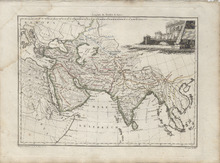Asie Ancienne (1812)
Single page historical copper engraved ap of the ancient Asian Continent. The map also covers Turkey, Israel, Lebanon, Italy, Croatia, Albania, Russia, Ukraine, Crimean Peninsula, Greece, Cyprus, Arabian Peninsula, Egypt, and the Eastern Coast of African Continent. The map shows several geographic details on cities, towns, rivers, mountains, and islands. The map features a vignette of a monument incorporating the title. Cities that appear on the map include: Malao (Berbera), Somalia, Adulis, Eritrea, Berenice Troglodytica, Syene (Aswan), Nechesia, Thebae (Thebes), Myos Hormos, Memphis, and Heroapolis, Egypt, Hyerosolyma (Jerusalem), Israel, Damascus, Syria, Tyrus (Tyre), Lebanon, Amathus, Cyprus, Aelana (Aqaba), Jordan, Modiana, Rhaunathi, Iambia, Arga, Macoraba, Thebae, Gerra (Gerrha), and Uumala, Saudi Arabia, Musa, Cane (Al Mukalla), and Sabbata, Yemen, Ausara, Oman, Babylon, Iraq, Susa, Ecbatana, Rages (Rey), Aspadana (Isfahan), Persepolis, Taoce, Carmana (Kerman), Paragarda, Gagana, Iran, Ozene, Barygaza (Bharuch), Heptanesium (Bombay or Mumbai), Harmagera, Nitria, Tyndis (Kadalundi), Muziris, Barace (Purakkad), Plitana, Tagara, Modura, Calinga, Gangesegia, and Palibothra (Pataliputra), India, Thinae, Thailand, Lahoru (Lahore), Aornus (Aornos), and Taxila, Pakistan, Maracanda (Samarkand), Uzbekistan, Bactra (Balkh), and Prophthasia (Alexandria Prophthasia), Afghanistan, Phasis (Poti), Georgia, Melitene (Malatya), Antiochia (Antioch), Iconium (Konya), Gangra (Çankırı), Byzantium (Istanbul), Mazaca (Kayseri), Sardes (Sardis), and Uins, Turkey Also the unknown cities of Tadmora, Dirithotis, Pella, Tadmora, Tisa, Malana, Pattalene, Gagasmira, Issedon Scythica, Maliana, Sogdae, Arachotus, Ladissa, Trapesus, and Artucona Source publication: Atlas Complet Du Precis De la Geographie Universelle De M. Malte Brun dressee par M. Lapie Capitaine Ingenieur Geographie Pierre M. Lapie (1779-1850) and his son Alexandre Emile Lapie (1809-1850) were French cartographers and engravers active in the early part of the 19th Century. The Lapies were commissioned officers in the French army holding the ranks of Colonel and Caipitan, respectively. Alexander enjoyed the title of "First Geographer to the King", and this title appears on several of his atlases. Both father and son were exceptional engraversand fastidious cartographers. Working separately and jointly they published four important atlases, an 1811 Atlas of the French Empire (Alexander), the 1812 Atlas Classique et Universel (Pierre), the Atlas Universel de Geographie Ancienne et Modern (joint issue), and the 1848 Atlas Militaire (Alexander). They also issued many smaller maps and independent issues. All of these are products of exceptional beauty and detail. Conrad Malte-Brun (1755-1826) was an important late 18th and early 19th Century Danish/French cartographer and revolutionary. Conrad was born in Thisted, Denmark. His parents encouraged him to a career in the Church, but he instead enrolled in the University of Copenhagen. In the liberal hall of academia Conrad became an ardent supporter of the French Revolution and the ideals of a free press. Despite the harsh censorship laws of crown prince Frederick VI, Malte-Brun published numerous pamphlets criticizing the Danish government. He was finally charged with defying censorship laws in 1799 and forced to flee to Sweden and ultimately France. Along with colleague Edme Mentelle, Malte-Brun published his first cartographic work, the Geographie mathematique, physique et politique de toutes les parties du monde (6 volumes published between 1803 and 1807). Conrad went on to found Les Annales des Voyages (in 1807) and Les Annales des Voyages, de la Geographie et de l'Histoire (in 1819). He also founded the Paris Societe de Geographie. In time, Conrad became known as one of the finest French cartographers of his time.
Member of
